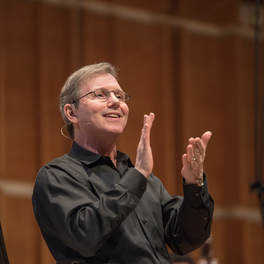 Conductor-composer-lecturer Robert Kapilow.
Conductor-composer-lecturer Robert Kapilow. On the one hand, the program featured Mozart’s Clarinet Concerto, to be played by the TSO’s principal clarinettist, Joaquin Valdepeñas. Nothing wrong with that idea! On the other, the concerto was to be enfolded in one of conductor-composer-lecturer Robert Kapilow’s “What Makes It Great?” programs, and that was something I felt a little uneasy about.
Yet I soon learned that Kapilow is very good at what he does. On stage with a keyboard, the TSO and Valdepeñas (to play short musical excerpts to support his talk) he was chatty and engaging – a cross between Leonard Bernstein and Malcolm Gladwell, with a dash of P. T. Barnum thrown in. His lecture was breezy and gently persuasive, as he invited listeners to consider that “it’s the little things that make a big difference.” Wisely, he produced no Schenkerian charts to illustrate his ideas. Rather, he explained through sound, constructing lesser versions of Mozart’s phrases – playing them on his keyboard, or in orchestrated snippets with the TSO – to show how Mozart’s ideas, and his treatment of his ideas, stood head and shoulders above what a lesser composer might have accomplished. If the devil is in the details, so too are the angels.
The audience, armed with new insights into Mozart’s Clarinet Concerto, had the immediate opportunity to apply that insight. Now Kapilow stepped up to the podium as conductor, to lead the TSO, with Valdepeñas as soloist.
There are several members of the TSO who are soloists at heart – and the orchestra’s principal clarinettist is certainly one of them. This tone rose gently above the orchestra, warm and glowing. And his interpretation was refined, with careful attention to every phrase. I could listen to him all day and night.
However, I wasn’t equally impressed with Kapilow – at least, not in the first movement. The lecturer who lavished attention on the smallest details transformed into a conductor who was content to press relentlessly forward, brushing details aside. While this approach gave the Allegro plenty of momentum, it limited what Valdepeñas could achieve as soloist, and gave the performance a blunt, goal-oriented quality (the goal being the end of the piece).
Fortunately, the next two movements fared better. In the Adagio, both Kapilow and Valdepeñas were on the same page – and their shared interpretation was tender and touching. (In a post-performance Q&A session with the audience, Valdepeñas said that the second movement of the Mozart Clarinet Concerto was his favourite piece of music – and judging from his sublime performance, this claim was entirely credible.) And the final Rondo was a marriage of the happiest qualities of the first and second movements: lots of energy and momentum, but also lots of attention to the small things, allowing the playful, joyful quality of the piece to shine through.
It was the critic-composer Virgil Thomson who famously disparaged the “music appreciation racket.” And yes, it can be a superficial exercise in preaching to the choir. But there was nothing superficial about Kapilow’s lecture. It was apparent to me on my first encounter with Kapilow that he has successfully drawn together a variety of skills for a useful purpose. He makes his audience listen better.
© Colin Eatock 2018
 RSS Feed
RSS Feed

